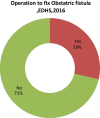Factors associated with obstetric fistula among reproductive age women in Ethiopia: a community based case control study
- PMID: 37221586
- PMCID: PMC10204224
- DOI: 10.1186/s12978-023-01622-y
Factors associated with obstetric fistula among reproductive age women in Ethiopia: a community based case control study
Abstract
Background: Obstetric fistula is a major public health concerns in Ethiopia. It is the most devastating cause of all maternal morbidities.
Method: Data from the 2016 Ethiopian Demographic Health Survey (EDHS) was analyzed. A community-based unmatched case control study was conducted. Seventy cases and 210 non cases were selected using random number table. Data were analyzed by using STATA statistical software version 14. Multivariable logistic regression model was applied to determine the factors associated with fistula.
Results: The majority of fistula cases were from rural residences. The multivariable statistical model showed that rural residence (Adjusted OR (AOR) = 5, 95% CI 4.26, 7.52), age at first marriage (AOR = 3.3, 95% CI 2.83, 4.60), poorest wealth index (AOR = 3.3, 95% CI 2.24, 5.01) and decision making for contraceptive use by husband alone (AOR = 1.3, 95% CI 1.124, 1.67) were factors significantly associated with obstetric fistula.
Conclusion: Age at first marriage, rural residence, poorest wealth index and decision making for contraceptive use by husband alone were significantly associated factors for obstetric fistula. Intervening on these factors will reduce the magnitude of obstetrics fistula. In this context there is in-need to improve on avoiding early marriage through awareness creation to the community and developing legal framework by the policymakers. Furthermore, information about the joint decision making to use contraceptives should be disseminated though mass-media and interpersonal channels.
Keywords: Ethiopia; Maternal morbidity; Obstetric fistula.
Plain language summary
Globally, 2–3 million women are affected by obstetric fistula. It is common in developing nations, mainly in sub-Saharan Africa and Southeast Asia where suitable, timely care and treatment are hard to find. This devastating condition adversely affects women’s physical and mental health. There is little research conducted in relation to the experiences of women living with leakage of urine and/or feces in Ethiopia. Therefore, this study provides a better understanding on obstetric fistula and its associated factors.The present study used the recent Ethiopia Demographic Health Survey (EDHS) 2016, to determine the associated factors of obstetric fistula among reproductive age group women (15–49 years) in Ethiopia.In this study rural residence, poorest wealth index, age at first marriage less than 18 years, and decision making for contraceptive use by husband alone were the associated factors of obstetric fistula. Intervening on these factors will reduce the magnitude of obstetrics fistula. In this context there is in-need to improve on avoiding early marriage through awareness creation to the community and developing legal framework by the policymakers. Furthermore, information about the joint decision making to use contraceptives should be disseminated though mass-media and interpersonal channels. Comprehensive intervention strategies should be customized at different government hierarchies to combat and reduce obstetric fistula.
© 2023. The Author(s).
Conflict of interest statement
The authors declare that they have no competing interests.
Figures
Similar articles
-
Awareness of obstetric fistula and associated factors among women in reproductive age group attending public hospitals in southwest Ethiopia, 2021.Reprod Health. 2021 Sep 15;18(1):183. doi: 10.1186/s12978-021-01228-2. Reprod Health. 2021. PMID: 34526056 Free PMC article.
-
Spatial variations and multilevel mixed effect analysis on determinants factors of modern contraceptive utilization among reproductive age women in Ethiopia; proven by Ethiopian mini demographic health survey 2019.BMC Womens Health. 2023 Feb 22;23(1):77. doi: 10.1186/s12905-022-02030-3. BMC Womens Health. 2023. PMID: 36814235 Free PMC article.
-
Prevalence of married women's decision-making autonomy on contraceptive use and its associated factors in high fertility regions of Ethiopia: a multilevel analysis using EDHS 2016 data.BMC Public Health. 2023 Jan 11;23(1):83. doi: 10.1186/s12889-023-15009-y. BMC Public Health. 2023. PMID: 36631790 Free PMC article.
-
Systematic review and meta-analysis of women's awareness of obstetric fistula and its determinants in Ethiopia.Front Glob Womens Health. 2023 May 19;4:1151083. doi: 10.3389/fgwh.2023.1151083. eCollection 2023. Front Glob Womens Health. 2023. PMID: 37275209 Free PMC article. Review.
-
Obstetric fistulas in Uganda: scoping review using a determinant of health approach to provide a framework for health policy improvement.BMC Pregnancy Childbirth. 2020 Apr 29;20(1):257. doi: 10.1186/s12884-020-02951-7. BMC Pregnancy Childbirth. 2020. PMID: 32349703 Free PMC article.
Cited by
-
Association between place of delivery, assistance during delivery and fistula occurrence in Afghanistan.Int Health. 2022 Nov 1;14(6):580-587. doi: 10.1093/inthealth/ihab074. Int Health. 2022. PMID: 34849946 Free PMC article.
-
Knowledge of obstetric fistula and contributing factors among reproductive-age women in Ethiopia: a systematic review and meta-analysis.AJOG Glob Rep. 2024 Nov 28;5(1):100426. doi: 10.1016/j.xagr.2024.100426. eCollection 2025 Feb. AJOG Glob Rep. 2024. PMID: 39810942 Free PMC article.
-
Variability and awareness of obstetric fistula among women of reproductive age in sub-Saharan African countries: A systematic review and meta-analysis.Heliyon. 2023 Jul 22;9(8):e18126. doi: 10.1016/j.heliyon.2023.e18126. eCollection 2023 Aug. Heliyon. 2023. PMID: 37560629 Free PMC article.
References
-
- Bulletin of the World Health Organization (WHO) 2015; 93:60–62. 10.2471/BLT.14.141473. - PubMed
-
- World health organization (WHO), data base. Obstetric fistula. 2018. https://www.who.int/news-room/facts-in-pictures/detail/10-facts-on-obste...
-
- 10 facts on obstetric fistula [Internet]. Geneva: World Health Organization; 2014. http://www.who.int/features/factfiles/obstetric_fistula/en/. Accessed 28 Nov 2021.
-
- Mini Demographic and Health Survey, 2019. Addis Ababa: Ethiopian Central Statistical Agency
-
- Getachew T, Ayele Taye A, Jabessa S. Survival analysis of time to recovery from obstetric fistula at Yirgalem Hamlin Fistula Hospital, SNNPR, Ethiopia. J Biom Biostat. 2015;6:3. doi: 10.4172/2155-6180.1000242. - DOI
MeSH terms
Substances
LinkOut - more resources
Full Text Sources



